Physical Address
304 North Cardinal St.
Dorchester Center, MA 02124
Acknowledgment: Thank you to Richard E. Brown and Elvin G. Zook for their past contributions to the creation of this chapter.
The fingernail serves many functions that are taken for granted in everyday use of the hand. The nail protects the fingertip, helps in regulation of peripheral circulation, and contributes to tactile sensation that assists us in picking up small objects. An abnormal nail is a functional and a cosmetic problem. Because of the prominence of the nail on the tip of the finger, the perionychium is the most frequently injured part of the hand. Doors are the most common source of trauma to the perionychium, followed by smashing the finger between two objects and lacerations from yard or workshop tools. The long finger is most frequently injured because of its increased exposure distal to the other digits. Similarly, the most distal part of the nail bed is the most frequently injured part of the perionychium, and often the hyponychium is involved as well.
The anatomic landmarks of the nail are shown in Fig. 9.1 . The perionychium includes the nail bed, nail fold, eponychium, paronychium, and hyponychium. The nail bed, the soft tissue beneath the nail, includes the germinal matrix proximally and the sterile matrix distally. The nail fold, which is the most proximal extent of the perionychium, consists of a dorsal roof and a ventral floor. The ventral floor is the germinal matrix portion of the nail bed. Paronychium refers to the skin on each side of the nail, and hyponychium refers to the skin distal to the nail bed. The eponychium is the skin proximal to the nail that covers the nail fold. Extending distally from the eponychium onto the nail is the nail vest or cuticle. The white arc of the nail just distal to the eponychium, known as the lunula, is the distal extent of the germinal matrix.
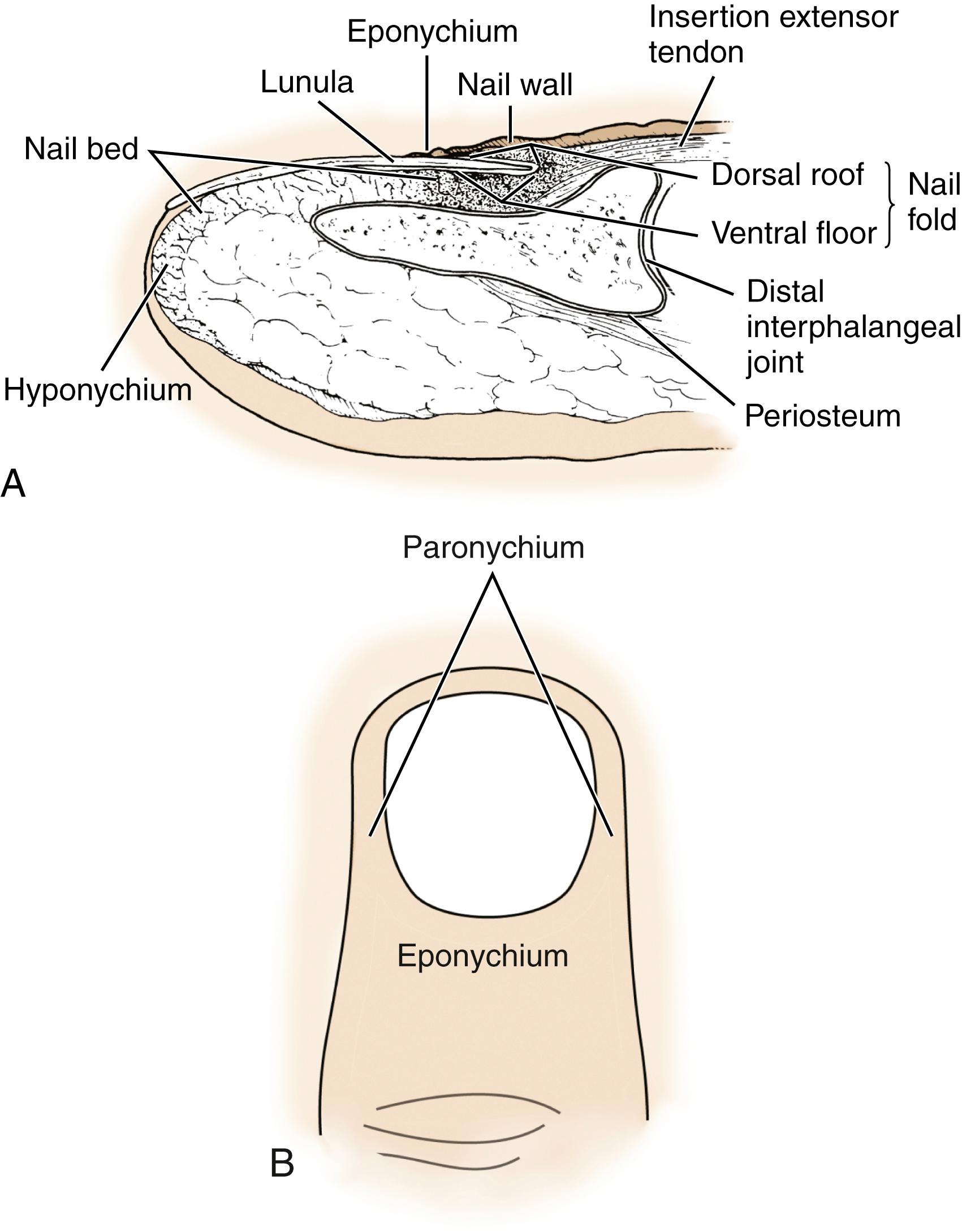
The germinal matrix produces about 90% of the nail volume, an important point in reconstruction of the nail bed. The sterile matrix adds a thin layer of cells to the undersurface of the nail, keeping the nail adherent to the nail bed. Scarring of the germinal matrix leads to absence of the nail, whereas injury to the sterile matrix leads to nail deformity. The dorsal roof of the nail fold produces the shine on the nail.
The blood supply of the perionychium comes from the terminal branches of the radial and ulnar volar digital arteries and capillary loops ( Fig. 9.2 ). The veins drain into the proximal nail bed and nail fold, then course randomly over the dorsum of the finger. , Sensation to the nail bed is supplied by dorsal branches of the volar radial and ulnar digital nerves and the most distal extent of the dorsoradial digital nerve branches.
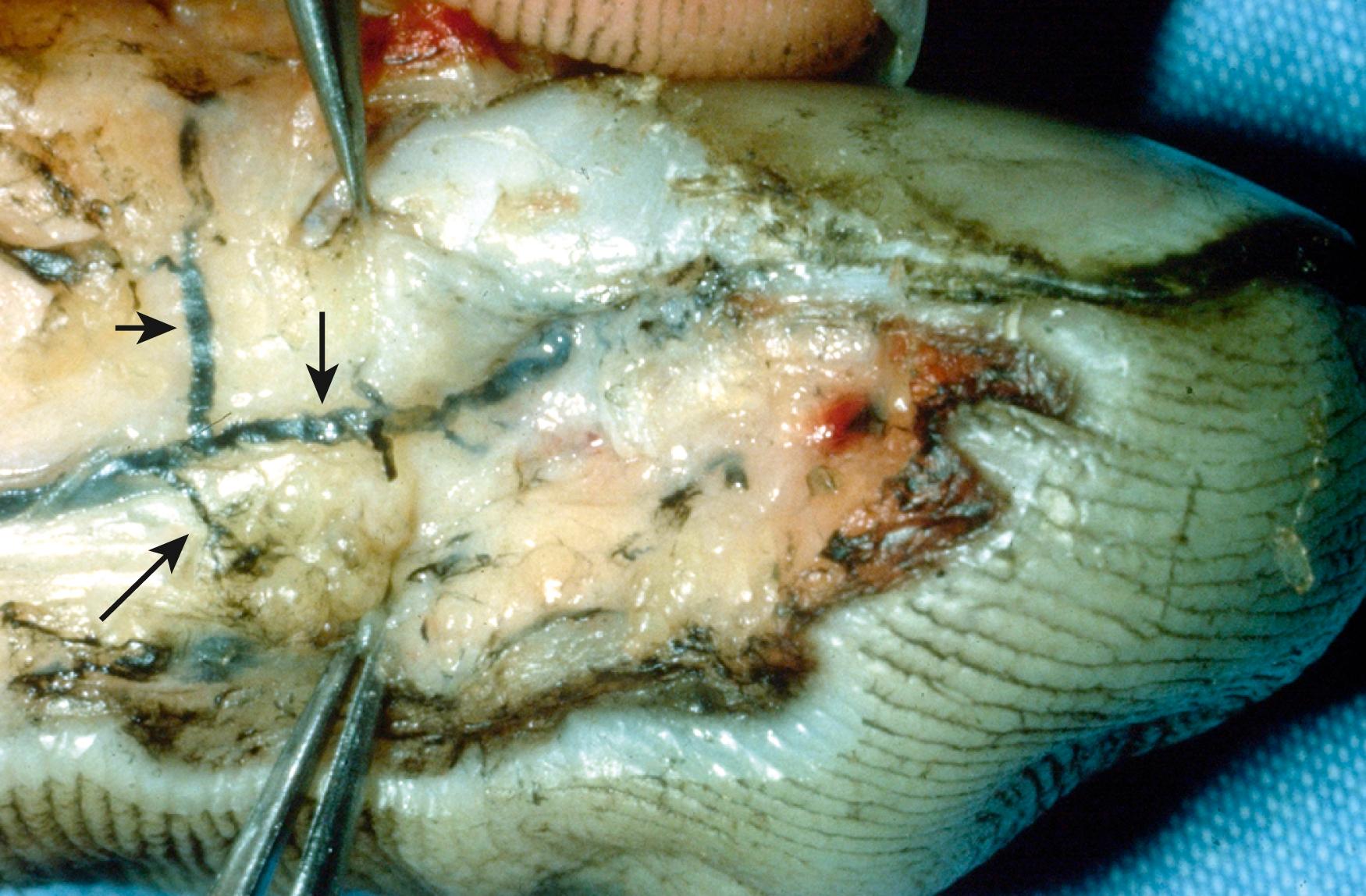
The numerous lymphatics of the nail bed roughly parallel the veins. The hyponychium contains the greatest density of lymphatics of any dermal area in the body, which aids in deterring infection in this frequently exposed area.
In the case of fingertip injuries, evaluation of the perionychium usually begins in the office or emergency department with the patient history. The injured finger can be examined without anesthesia, but a digital finger block is needed for cleansing of the finger and possible removal of the nail to determine the extent of nail bed injury. Visualization of the nail bed under loupe magnification and with tourniquet hemostasis is ideal. Evaluation of an injured perionychium includes assessment for associated injuries such as distal phalanx fracture.
We recommend a radiograph of the involved finger because of the 50% chance of fracture with a nail bed injury. Lateral and anteroposterior (AP) views will demonstrate the extent of bony injury.
Most nail bed trauma falls into the classification of simple lacerations, stellate lacerations, severe crush, or avulsions ( Fig. 9.3 ). , These injuries occur in the same order of frequency. A fifth category of injury is subungual hematoma. Because of the inability to see the extent of the nail bed laceration, subungual hematomas can be the most challenging injury to treat.
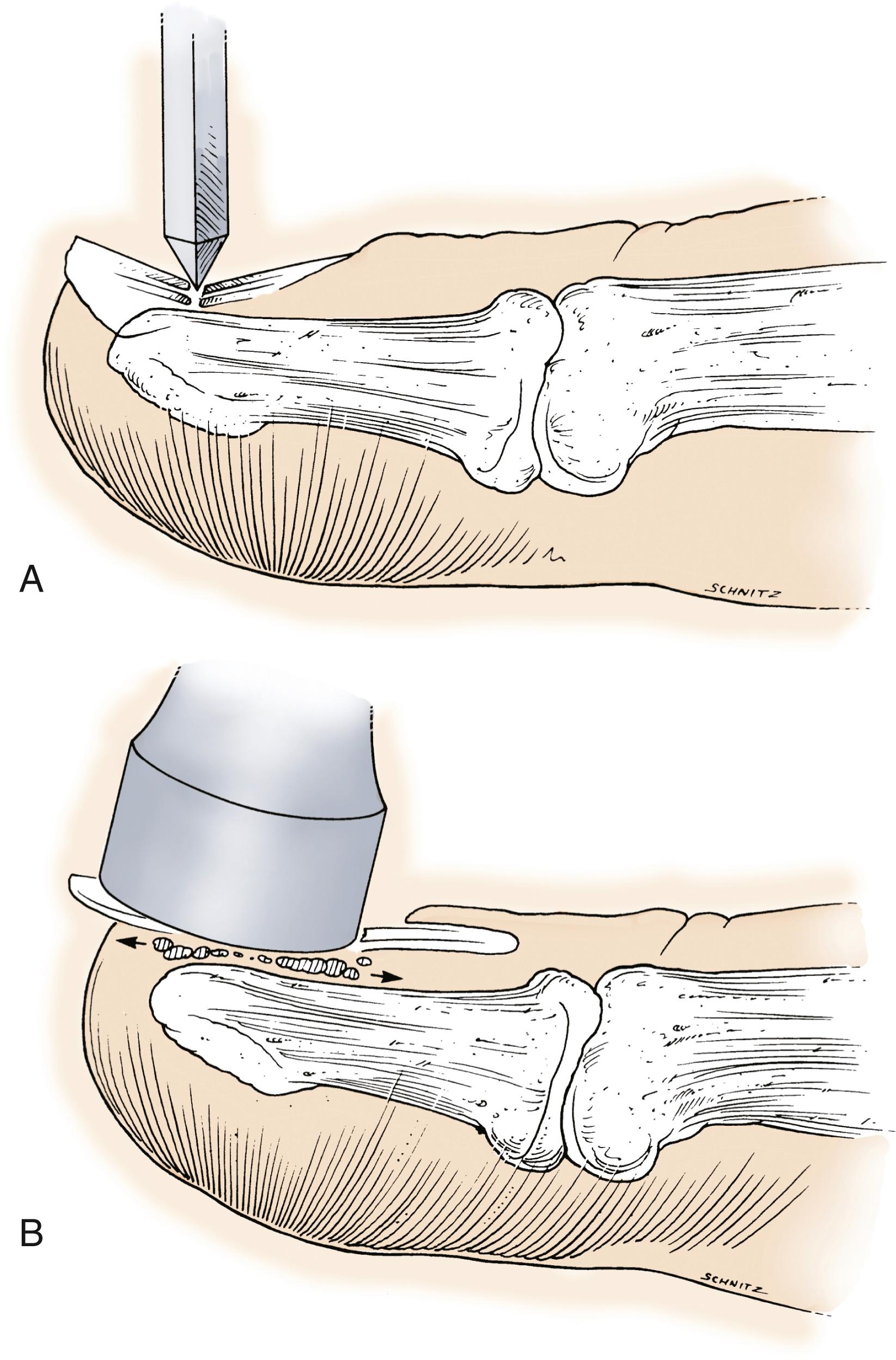
Compression of the nail onto the underlying distal phalanx can lead to a laceration in the nail bed and bleeding beneath the nail, known as subungual hematoma. If the nail is intact, the pressure of the blood within this confined space frequently causes severe throbbing pain, and evacuation of the hematoma is indicated.
Before evacuation of the hematoma, the finger should be surgically prepared. Surgical preparation is essential to decrease the chance of bacterial inoculation of the subungual space on trephination of the nail. We prefer a povidone-iodine (Betadine) soap scrub. Trephination of the nail has been performed with drills, needles, and paperclips heated in an open flame until red hot. We prefer a battery-powered microcautery unit, available in most emergency departments ( Fig. 9.4 ). The heated tip is passed through the nail and is cooled by the hematoma, avoiding injury to the nail bed. The hole must be large enough to allow continued drainage; otherwise, the hematoma recurs if a clot seals the hole.
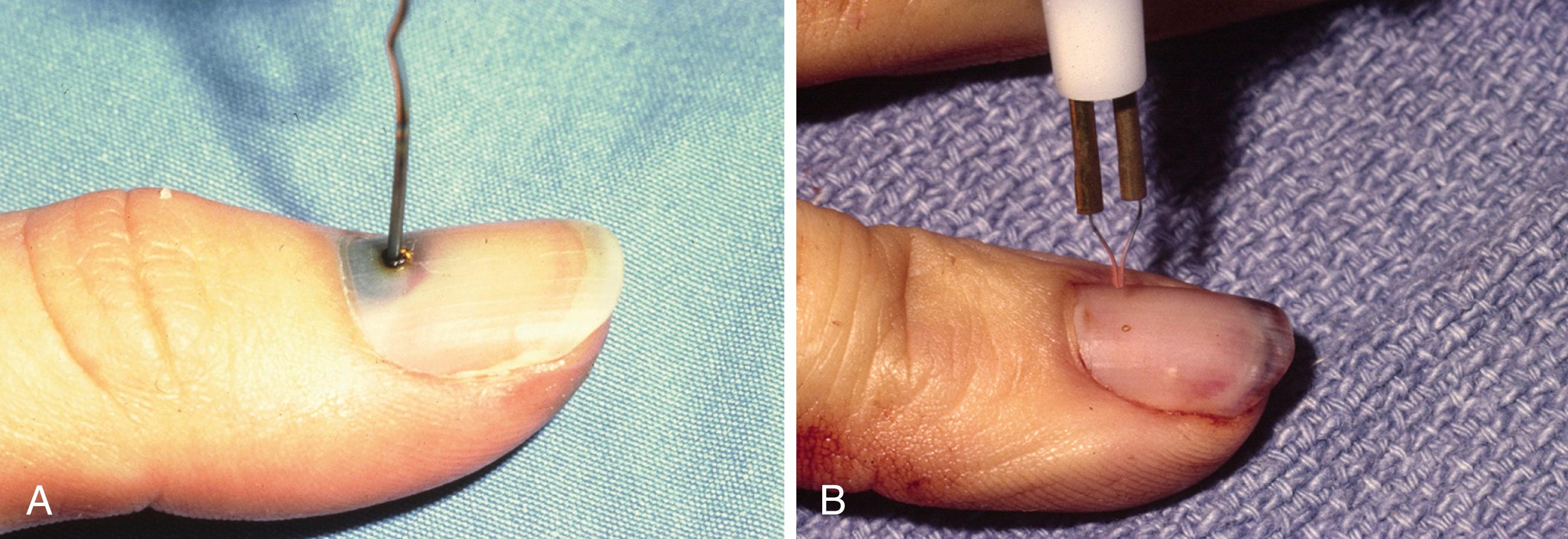
In the past, we recommended removal of the nail and repair of the nail bed if greater than 25% to 50% of the nail was undermined by blood. , However, a prospective 2-year study of 48 patients with hematomas showed no complications of nail deformity with drainage only, regardless of hematoma size or the presence of a distal phalangeal fracture. Our cutoff for nail removal and repair subsequently became greater than 50%. At the present time, the decision for removal of the nail is based primarily on evaluation of the nail edges rather than the percentage of hematoma. Generally, if the nail and nail edges are intact, we recommend drainage only. If the nail is broken or the nail edges are disrupted, we recommend removal of the nail with exploration and repair of the nail bed.
Nail Bed Repair
This discussion on nail bed repair includes the various points pertinent for treatment of simple lacerations, crush injuries, and avulsion injuries. A finger block is performed with 1% lidocaine with epinephrine (1:100,000), which has been shown to be safe for digital blocks. The finger and often the entire hand are surgically prepped and draped. A Penrose drain is wrapped from the distal fingertip to the proximal finger for exsanguination. The Penrose is clamped with a hemostat at the level of the proximal phalanx and the distal end is unwrapped to expose the injured area. This allows for hemostasis and adequate visualization of the nail bed. If a Penrose is not available, the finger of a glove can be placed on the injured finger, cut at the tip, and rolled down to the proximal finger as a tourniquet. If this technique is utilized, one must not forget to remove the rolled-up glove at the base of the finger, which can lead to severe ischemic problems in the finger if accidentally left in place. The nail is removed with a periosteal elevator or iris scissors. The scissors are inserted beneath the free edge of the nail and gently opened and closed, working them proximally. If curved scissors are used, the tips are pointed superficially toward the nail to avoid injury to the nail bed. Caution must be used with an elevator because blunt force can tear the nail bed. We recommend a Kutz elevator because it is smaller than a Freer elevator and does less damage to the nail bed. The nail is cleaned by scraping the undersurface to remove the residual fibrinous tissue and soaked in povidone-iodine during the repair of the nail bed laceration.
The nail bed is examined under loupe magnification. Irregularities of the edges are trimmed if it is possible to do so without compromising the repair. Debridement must remain conservative, however. The nail bed is adherent to the distal phalanx and difficult to mobilize. Undermining the edges approximately 1 mm allows for slight eversion, but minimal to no mobilization. It is better to leave contused edges in place if there is doubt of closure, rather than to leave a defect from aggressive debridement. The wound is copiously irrigated with normal saline. The nail bed is repaired with a 7-0 chromic suture on a micropoint spatula, double-arm, GS-9 ophthalmic needle (Ethicon). The curve of this needle allows easier passage through the nail bed, which is adherent to the periosteum. The suture is cut in half and the double needle provides a spare in case one is bent or broken. Simple nonburied sutures are placed.
With stellate lacerations and especially with crush injuries, the nail is often fragmented. The nail is removed very cautiously to avoid injury to the small segments of adherent nail bed. With meticulous approximation of the multiple segments, stellate lacerations have a good outcome ( Fig. 9.5 ). Crush injuries have a poorer prognosis, likely because of the presence of greater contusion along with the complicated laceration.

After repair of simple or complex lacerations (or placement of a nail bed graft, when needed), the nail bed must be protected. The best option is the native nail if this is available. The nail also acts as a perfect mold for the repaired nail bed. The nail is removed from the povidone-iodine soak and irrigated with normal saline. A hole is cut in the nail with a pair of fine scissors or burned with a battery-operated cautery to allow drainage of serum or hematoma from the subungual space. We prefer to place the hole away from the repair when possible. The nail is secured in place with a 5-0 nylon mattress suture through the nail and nail fold or a simple suture through the edge of the nail and hyponychium. The nail prevents scar formation between the ventral and dorsal surface of the nail fold. The nail stiffness prevents it from flipping out of the nail fold when the hyponychium suture is used. Dermal adhesives , have been advocated for nail adhesion, but we have no experience with this technique. If the nail is unavailable or is too badly damaged, a nail-shaped piece of 0.020-inch reinforced silicone sheeting may be substituted. Silicone is less stiff and requires a nail fold suture to hold it in place beneath the nail fold ( Fig. 9.6 ). Silicone is able to mold the edges of the repair more accurately than firmer prosthetic materials recommended by Ogunro. If neither nail nor silicone is available, a single thickness of nail-shaped nonadherent gauze or suture packet material may be placed in the nail fold.
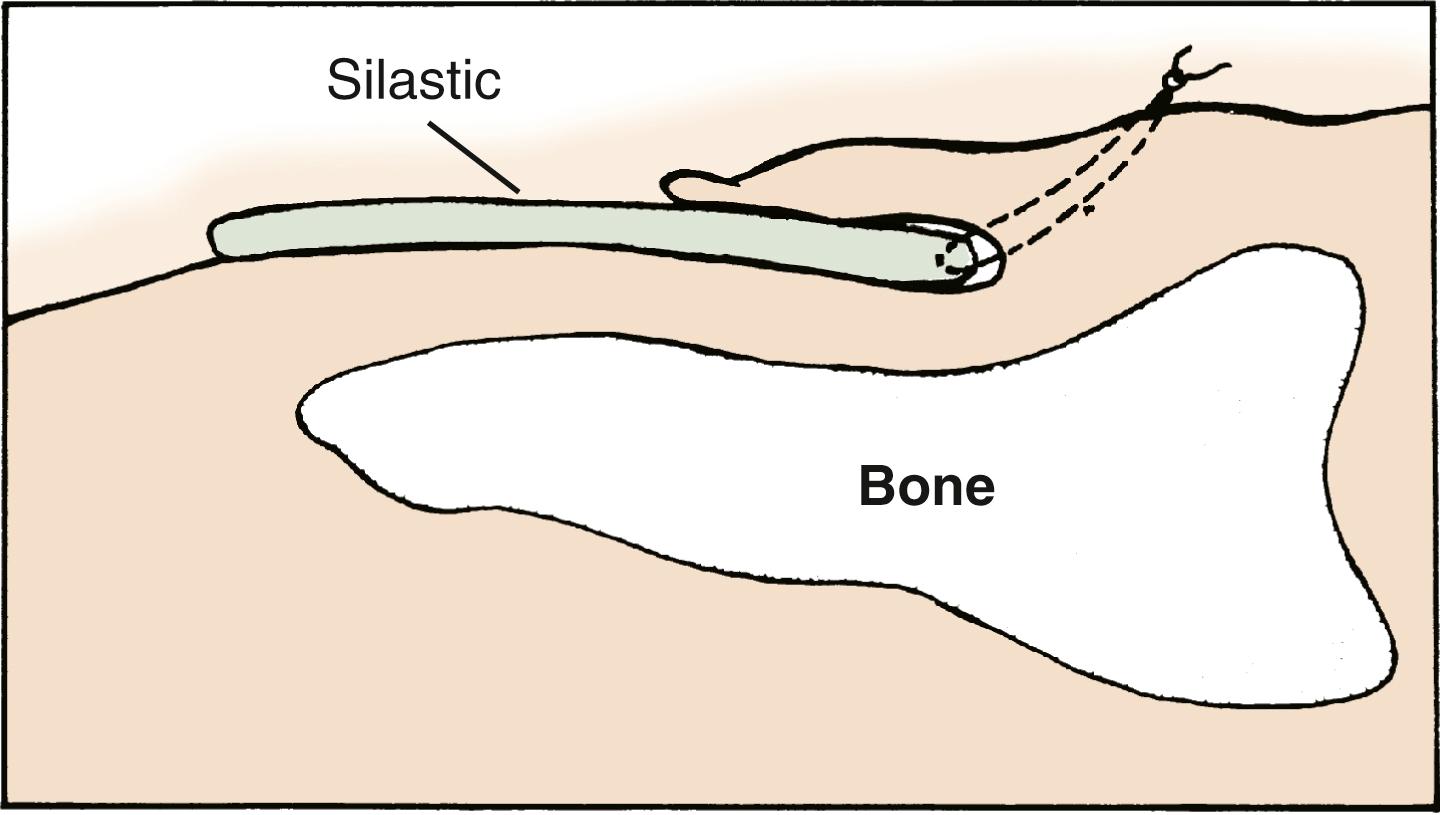
The finger is wrapped in nonadhesive gauze and small gauze bandages and wrapped with a small gauze roll. Avoid tightly wrapping the gauze, and do not use Coban wrapping to prevent tip ischemia. Verify that the tourniquet has been removed for the proximal finger. We recommend a four-prong or volar aluminum splint for protection of the repair and reduction of pain. The splint is worn for 2 to 3 weeks or longer if a fracture is present. Immobilization of the distal interphalangeal (DIP) joint is necessary only if a significant distal phalanx fracture is present. Patients are instructed to keep the finger and dressing dry until follow-up and to keep the hand elevated. If a nail bed graft is taken, the donor site is treated in a similar fashion with replacement and stabilization of the nail and a protective dressing.
Use a digital block with 1% lidocaine with 1:100,000 epinephrine and apply a tourniquet.
Remove the nail with an elevator or curved iris scissor, avoiding injury to nail bed.
Assess nail bed injury with loupe magnification and debride conservatively.
Copiously irrigate the wound with normal saline.
Repair nail bed edges with 7-0 chromic suture with meticulous approximation.
Splint the nail bed repair with the native nail secured in the nail fold.
Dress the fingertip with nonadherent pad and gauze/wrap and remove the proximal tourniquet.
Place four-prong or volar aluminum splint to protect the repair.
Nail bed avulsion often leaves a fragment of nail bed attached to the undersurface of the avulsed nail and often involves most of the nail bed. An avulsion commonly manifests as laceration of the nail bed within the nail fold with the nail bed attached distally. In a child, avulsion of the nail bed out of the nail fold suggests a Salter I fracture. Radiographic evaluation, especially in the lateral view, is recommended in children to rule out a Seymour fracture in which the nail bed is interposed in the physis of the distal phalanx. This must be removed from the physis and the nail bed and fracture reduced if this is the case. An attempt should be made to find the nail if it does not accompany the patient.
Adequate visualization and repair require an incision in the eponychium. The incision is made perpendicular to the lateral curved portion of the eponychial fold and may be necessary on both sides ( Fig. 9.7 ). The nail bed is repaired under direct visualization, and the eponychial incisions are closed with 6-0 nylon.
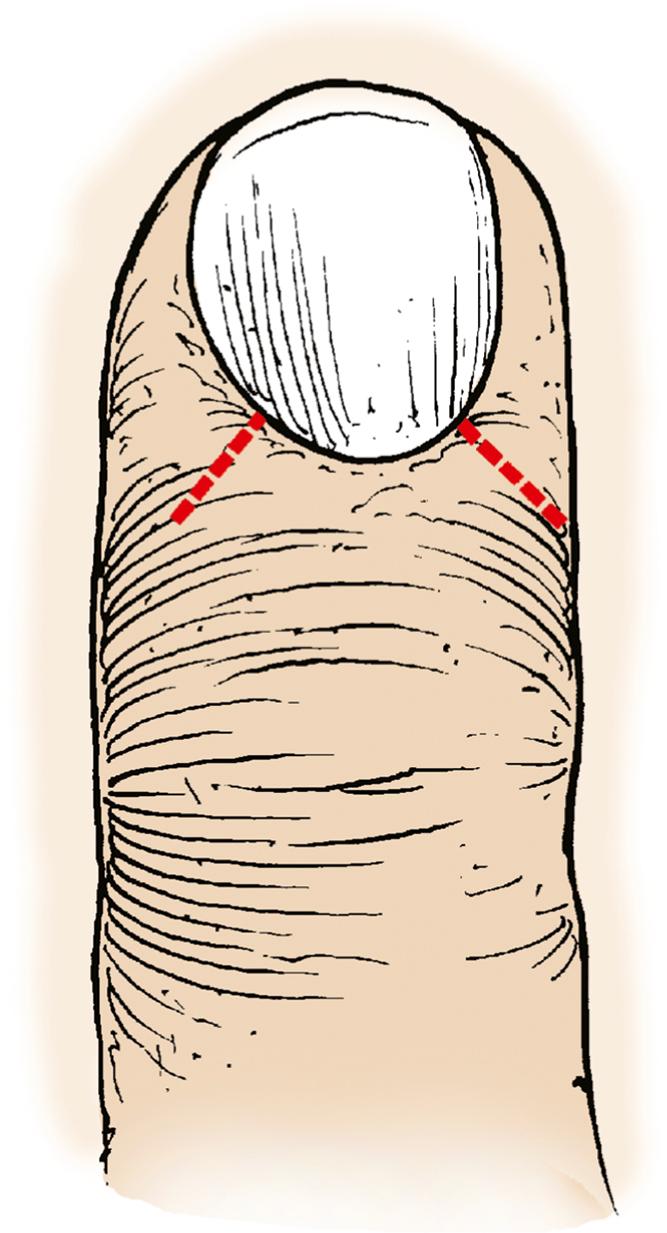
The avulsed nail bed is replaced as a nail bed graft with the nail acting as an optimal graft bolster. If the nail fragment is large, the nail is trimmed back 1 to 2 mm from the outer edge of the nail bed to allow suturing of the nail bed ( Fig. 9.8 ). If the nail fragments are small, the nail bed fragments are removed from the nail and replaced as nail bed grafts. The nail graft can be placed on the bare cortex as the distal phalanx is one of the few sites where a graft can survive on bone. A nail graft of less than 1 cm in diameter usually takes by inosculation and vascular ingrowth from the periphery. Very small nail bed fragments may be more difficult to remove. Although rarely the case, if there is concern about further injury to the nail bed fragment on attempted removal, the entire nail is replaced without separation of the nail bed fragment from the nail or suturing of the nail bed.
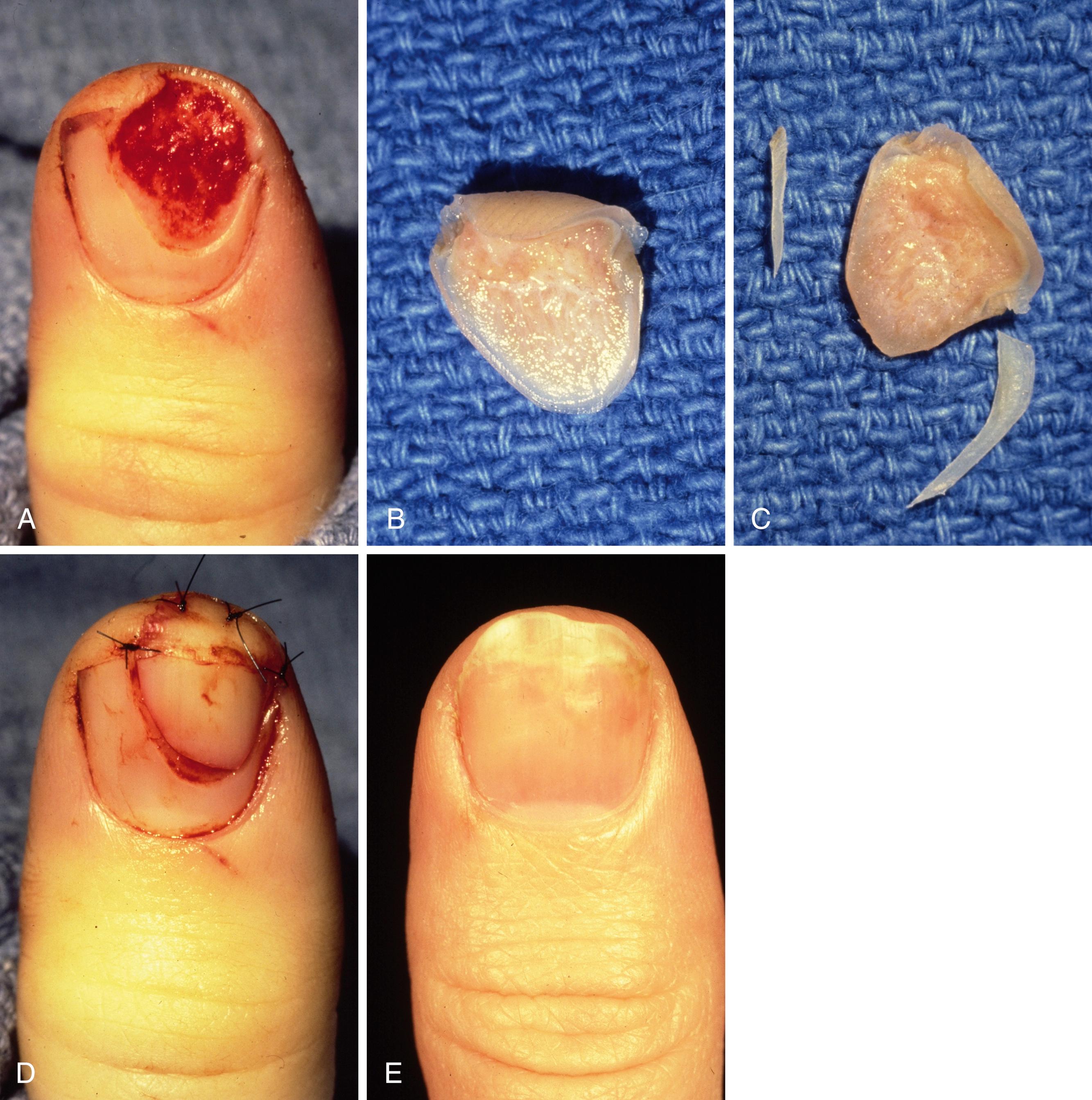
A split-thickness injury of the nail bed regenerates and does not need closure. Small areas of full-thickness nail bed loss left to heal by secondary intention generally result in scarring and nail deformity. Johnson advocated releasing incisions in the lateral paronychial folds with advancement of the germinal matrix toward the center of the nail. Favorable features that increase success of this lateral mobilization include a defect less than one-third of the nail width, good condition of the matrix to be mobilized, and careful elevation and advancement of the matrix. We have found this technique useful in the acute setting with a defect of 3 to 5 mm.
There are other options for closure of sterile matrix defects, including split-thickness or full-thickness nail bed grafts. Use of a split-thickness nail bed graft allows for harvest of nail bed from adjacent uninjured nail bed without altering nail growth at the donor site. If there is inadequate undamaged area on the nail bed from which to harvest, such as a defect greater than 50% of the nail bed, the nail bed graft should be harvested from an adjacent finger or toe ( Fig. 9.9 ). Patients often choose to have a graft harvested from the toe rather than another finger. From a clinical standpoint, the toe is likely a better option, owing to the potential risk of donor site nail deformity if the graft is harvested too deeply.
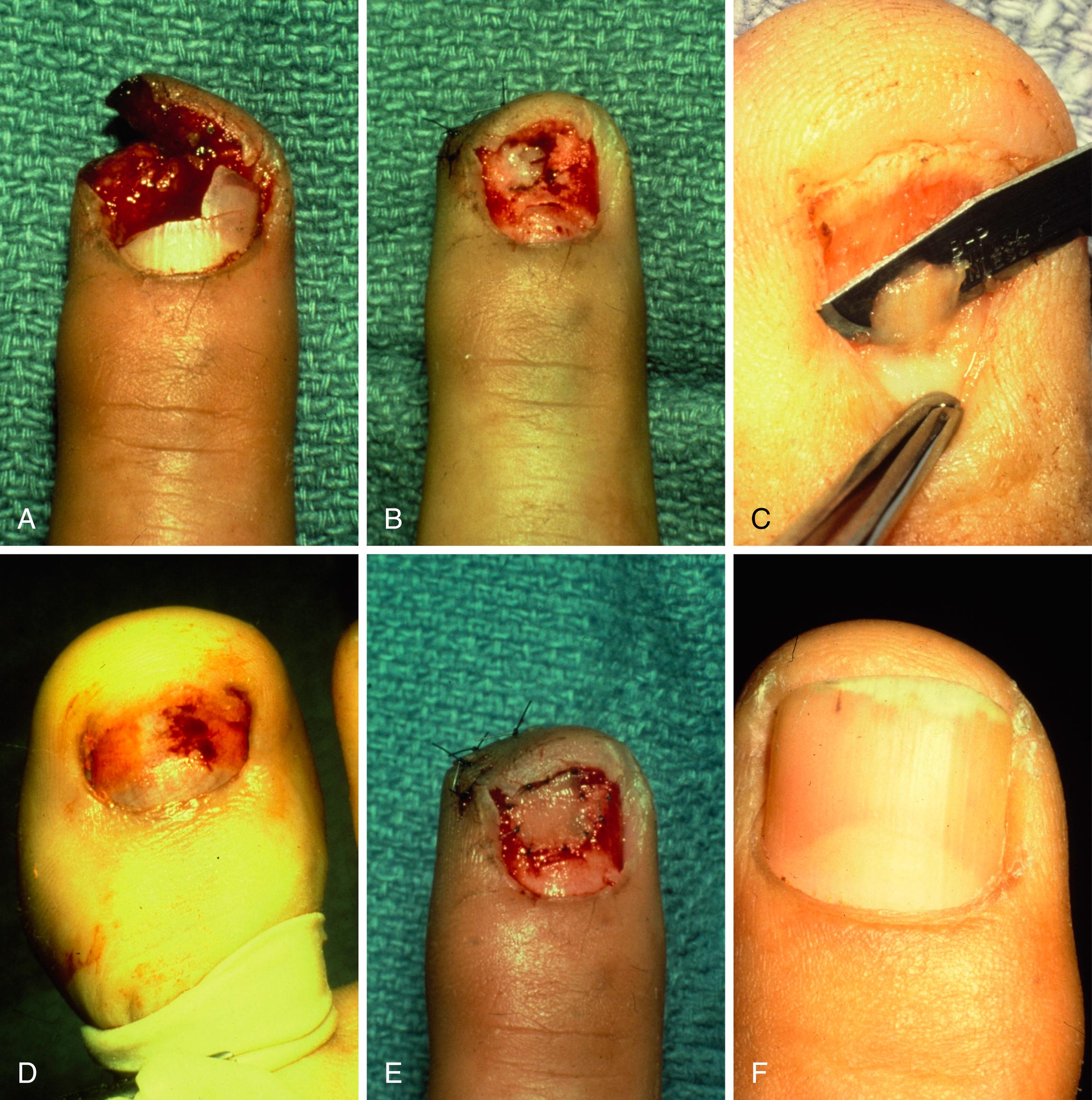
Full-thickness nail bed grafts are rarely used except when there are salvageable spare parts that would otherwise be discarded. Otherwise, a full-thickness graft would leave a deformity of the nail at the donor site. A full-thickness nail bed graft is necessary, however, when replacing lost germinal matrix. Another situation in which full-thickness grafts are chosen involves injury to the perionychium surrounding the nail bed. Zaias determined that there are no living cells in split-thickness nail bed grafts, and the recipient site is resurfaced with cells from the surrounding hyponychium, eponychium, and paronychium. If the surrounding perionychium is also missing, a full-thickness nail bed graft, which possesses living cells, would yield superior results compared with a split-thickness graft.
Sugamata treated a small series of nail bed wounds with artificial dermis. The artificial dermis was placed as a substitute for the missing part of nail bed in patients without an available amputated piece or unwilling to sacrifice another digit for the nail bed graft. Although he does not specify if the nail bed wound involved the sterile versus germinal matrix, all patients regenerated nail and were satisfied with the result. We suspect this technique would not be successful if the germinal matrix portion were involved and recommend acellular dermal matrix grafts for sterile matrix defects only. Acelullar dermal matrix is a good alternative when no donor nail bed graft is available and the patient does not agree to use of another fingernail or toenail bed as a donor site.
The finger or toe to be used as the donor is anesthetized with a digital block. After exsanguination, a digital tourniquet is placed for hemostasis, and the nail is removed. If possible, only a portion of the nail is removed, leaving the proximal nail intact within the nail fold. If a sterile marking pen is available, it is helpful to mark the area of graft needed on the donor site. A split-thickness nail bed graft (approximately 0.010-inch thick) is harvested with a No. 15 scalpel (see Fig. 9.9C ). Harvesting must be done carefully and slowly. The scalpel is placed parallel to the nail bed, and a back-and-forth sawing motion is used. To ensure thinness of the graft, we recommend visualization of the blade through the graft. It is better for the graft to be too thin than too thick. A thick graft may result in full-thickness donor loss, which likely leads to donor site deformity. A large graft is more difficult to harvest because of the curve of the nail bed, and it increases the chance of an accidental full-thickness harvest. To avoid this possibility, we use the tip of the blade while picking up the edge of the graft with fine forceps. The graft is sutured into the defect with 7-0 chromic sutures.
An associated distal phalanx fracture occurs with 50% of nail bed injuries. Nondisplaced fractures and distal tuft fractures are treated with repair of the nail bed and replacement of the nail as a splint. The curve of the nail and its close approximation to the underlying bone make an excellent splint to maintain fracture reduction. A tension band suture over the replaced nail can provide further stability to the fracture ( Fig. 9.10 ). If the nail is missing, the fracture may need to be pinned for better stabilization.
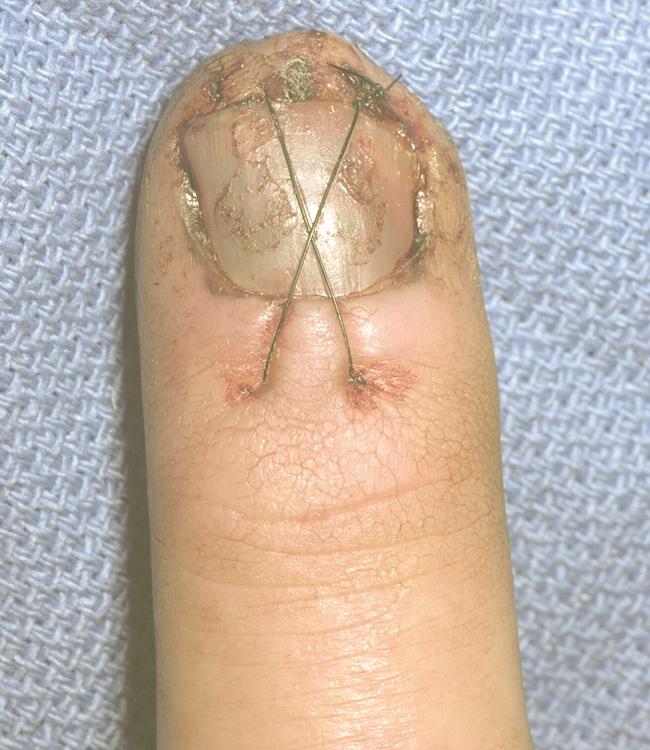
Displaced fractures, especially fractures proximal to the nail fold, are reduced and fixed with 0.028-inch longitudinal or crossed Kirschner wires ( Fig. 9.11 ). The use of a single wire is not recommended. Although a single wire can reduce the fracture, it cannot eliminate axial rotation. If only a small nail bed laceration is present, wires are passed in a retrograde fashion. However, with large nail bed lacerations, the wires are passed antegrade through the distal fragment, then retrograde into the proximal fragment. Crossing the DIP joint should be avoided if possible. With crush injuries, the distal phalanx fracture is often comminuted with small, fractured pieces adherent to the nail bed. In this case the bony fragments are reduced with reapproximation of the nail bed using the nail as a splint. If the nail is unavailable for use as a splint, a piece of reinforced silicone is recommended. The goals of distal phalanx reduction are bony union and an even dorsal cortex. An uneven cortex would impair nail bed healing and lead to a nail deformity.
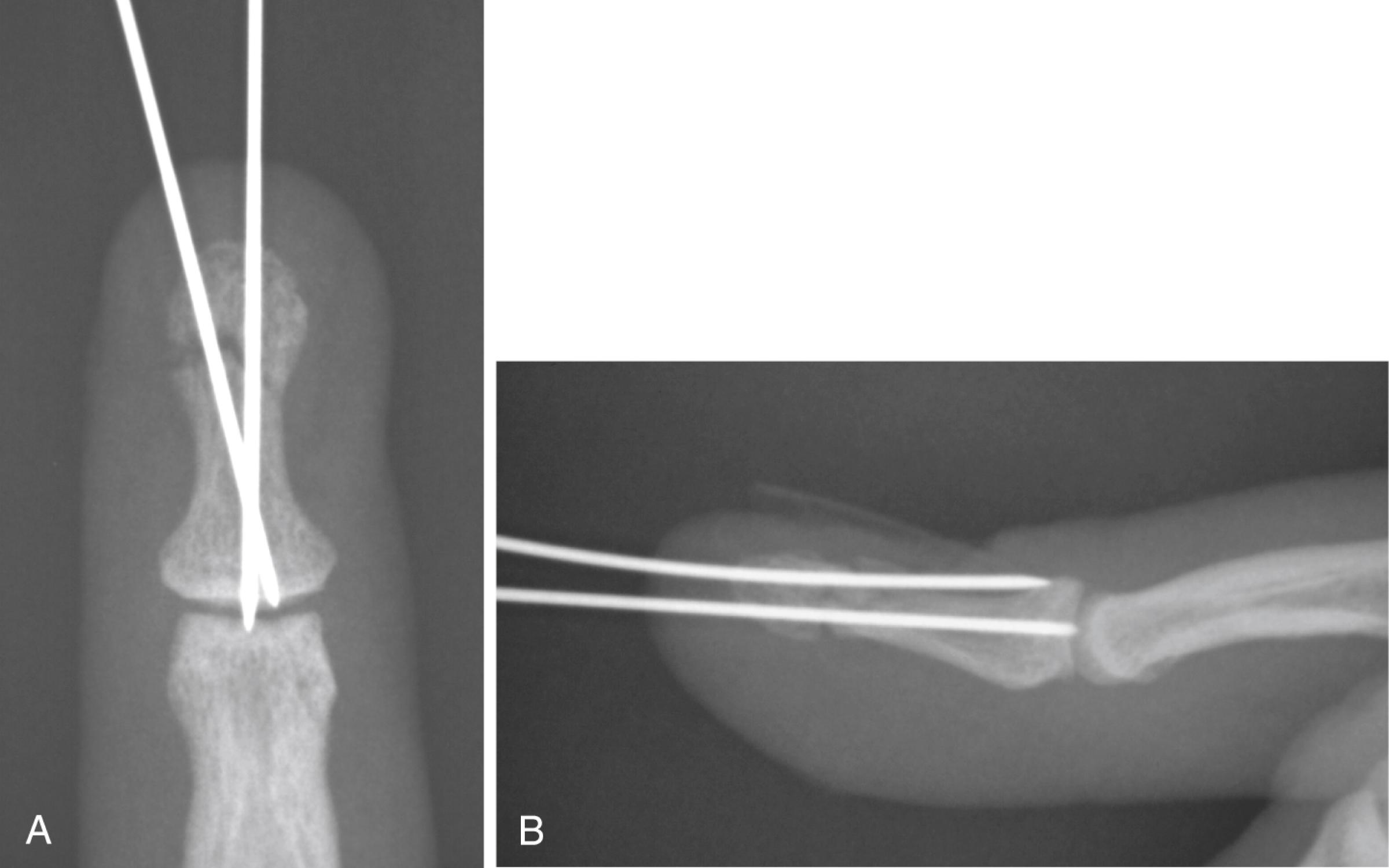
Salter I fractures are often reduced with repair of the nail bed alone. Pinning of the fracture should be avoided unless it is unstable. The patient and parents should be informed that growth of the distal phalanx may be affected, even with adequate reduction.
Fingertip amputation can be treated in multiple ways, usually based on the remaining proximal tissue and the presence and quality of the amputated piece. Options include revision amputation, closure with flaps and nail bed grafts, or replantation. Revision amputation is most successful when the tissue is closed without tension to avoid hook nail deformity. Length can be preserved with local flaps and use of the amputated nail bed as a graft. The eponychial flap used in conjunction with a volar flap and the fenestrated adipofascial reverse flap help preserve length of the digit and nail bed. Eponychial shortening such as backward translocation or eponychial flaps “lengthen” the visible nail for a more esthetic outcome. Replantation is most successful when the amputation is proximal to the area of the paronychium through the proximal aspect of the distal phalanx. Amputations through the nail bed are less successful because of the size of the vessels.
Netscher and Meade described success with the use of full-thickness graft of hyponychium, nail bed, and paronychium for amputations between the midportion of the nail and just proximal to the eponychium. In several cases, the distal phalanx was replaced as a graft and covered with regional flaps. The graft was placed onto the deepithelialized flaps. This would allow for preservation of length when successful.
Our preference for treatment is discussed from a distal to proximal direction of injury. On the rare occasion that the distal phalanx is covered by a layer of soft tissue, the amputated piece can be defatted and replaced as a skin or nail bed graft, or the area can be left to heal by secondary intention, especially if less than 1 to 1.5 cm in size. If the distal phalanx is exposed, the options consist of trimming back the bone to allow for primary closure or advancement of local “V-Y” flaps or regional thenar or cross-finger skin flaps to preserve length and supply adequate soft tissue bulk to support the nail bed. In both cases, when suturing the fingertip skin to the distal nail bed, tension should be avoided. Tension at the closure causes volar curvature of the distal nail bed and plate, leading to a hook nail. If a portion of the distal phalanx is absent, the nail bed is shortened to the end of the remaining distal phalanx before repair to avoid hooking of the nail from loss of bony support. If the amputated piece has both bone and nail bed present, it can be used as a composite graft. The bone segment is fixated to the distal phalanx with a single Kirschner wire and sutured to a “V-Y” advancement flap from the palmar digital surface.
More proximal amputations involving the midportion of the nail bed can be managed with local and regional flaps. We use local volar and lateral “V-Y” advancement flaps and regional cross-finger and thenar flaps to provide tip coverage ( Figs. 9.12 and 9.13 ). “V-Y” advancement flaps cannot be advanced more than 5 to 10 mm. These flaps can be used to close defects primarily involving the volar and distal fingertip or can be used with nail bed grafts to reconstruct the entire fingertip. Such flaps provide excellent coverage and can be deepithelialized to provide a vascularized bed for placement of the nail bed graft. Full-thickness nail bed grafts from the amputated part or a split-thickness nail bed graft from an adjacent finger or toe may be used.
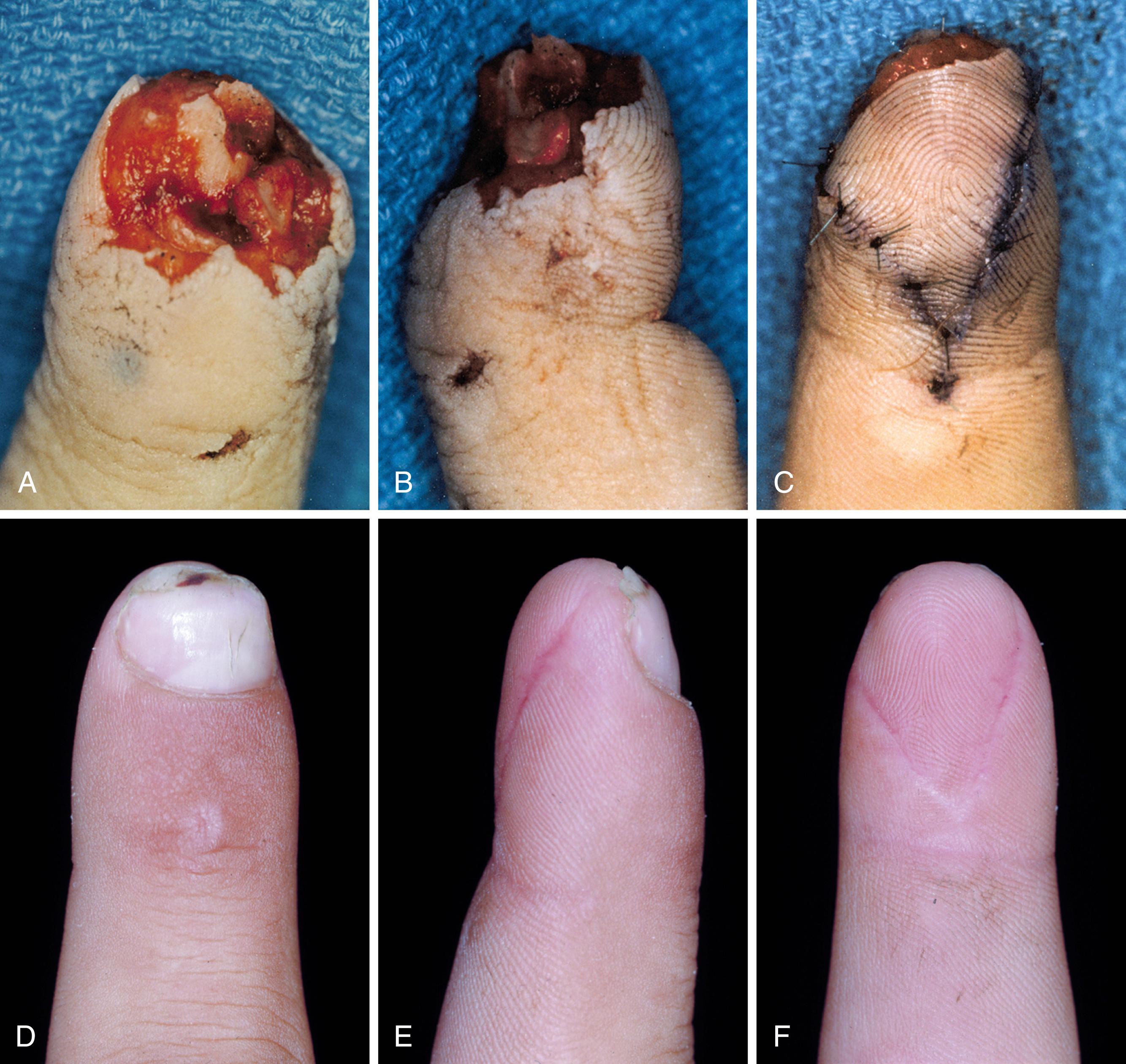
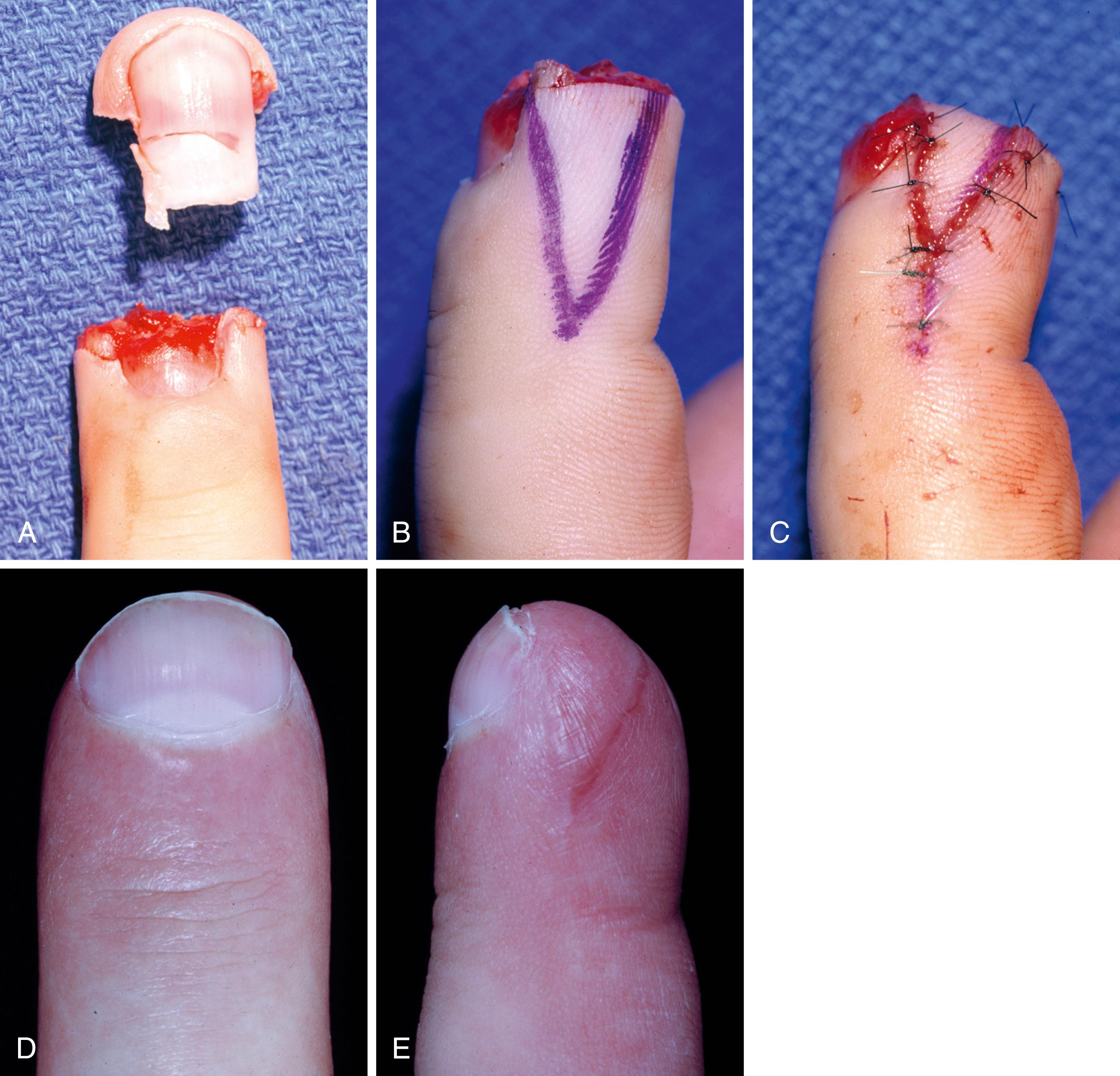
Amputations through the eponychium may be replanted, but success is variable; therefore we most often perform revision amputation at the level of the eponychium. If 25% or greater of the nail bed distal to the eponychium is present, the patient benefits from maintaining that nail. If less than 25% remains, however, we recommend resection of the remaining nail bed. This resection requires removal of the dorsal roof and ventral floor of the nail fold. The eponychial skin is left intact to use for coverage.
In children, the tip of the finger is often avulsed with the nail bed. In these cases, we approximate the edges of the nail bed and fingertip skin as a composite graft. Debridement of this composite graft is minimal to allow for maximal inosculation effect. Longitudinal or crossed pins are used to hold the bone in place. With young children, we occasionally use hypodermic needles in place of Kirschner wires for the bony reduction. The younger the child, the better chances for “take” of a composite graft of skin and nail bed. Our greatest success rate is for children 3 years old and younger. Alternatively, in an older child, a “cap” graft is likely to have greater success. This procedure includes removal of the bone fragment and defatting of the skin for use of the piece as a full-thickness skin or nail bed graft.
Occasionally, a nail bed injury is seen hours or days after the injury, with or without previous treatment. The first decision must be whether the initial care was adequate and, if it was not, whether more should be done. If there is any question, the nail bed is explored and accurately approximated; this can usually be done 7 days after injury. Any untreated or maltreated distal phalangeal fractures should also be treated appropriately, and the patient should be placed on perioperative antibiotics. Although the chance of infection may be greater with delayed treatment, a nail deformity occurs if nothing is done. We believe the risk is worth taking.
Become a Clinical Tree membership for Full access and enjoy Unlimited articles
If you are a member. Log in here